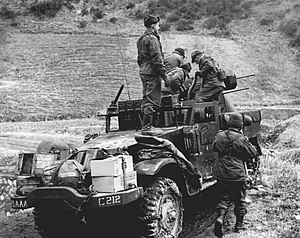| M17 Half-track | |
|---|---|
 The M16 Half-track similar to M17. | |
| Type | Self-propelled anti-aircraft weapon |
| Place of origin | United States |
| Service history | |
| In service | 1943-1945[1] |
| Used by | Soviet Union |
| Wars | World War II |
| Production history | |
| Designer | International Harvester |
| Designed | 1941-1943[1] |
| Manufacturer | International Harvester |
| Produced | 1943-1944 |
| No. built | 1000 |
| Specifications (without winch[3]) | |
| Mass | 19,700 lb (8,900 kg) loaded |
| Length | 20 feet 2 3⁄16 inches (6.15 m) |
| Width | 7 feet 3 inches (2.21 m) |
| Height | 6 feet 5 1⁄4 inches (1.96 m) to top of cab |
| Crew | 5 |
|
| |
| Armor |
Hull: 6 mm (0.24 in) Windscreen visor: 12.7 mm (0.50 in) |
Main armament | 4x .5 inch (12.7 mm) M2 Browning machine gun in a M45 Quadmount[2] |
| Engine |
IHC RED-450-B 141 hp (105 kW) |
| Suspension |
beam axle on leaf springs(front) tracks on vertical volute springs(rear) |
Operational range | 200 mi (321.9 km) |
| Maximum speed | 42 mph (68 km/h) |
The M17 Multiple Gun Motor Carriage was a US self-propelled anti-aircraft weapon produced by International Harvester for Lend-Lease to the Allies during World War II. The M17 was a four-heavy machine gun mounting on a M5 Half-track chassis. International Harvester produced 400 M17 half tracks in 1943 and 600 in 1944. All were provided to the Soviet Union in 1943 and 1944.[4]
Development[]

The M5, what the M17 is also based on
The first MGMC Half-tracks were the two-gun M13 and M14 based on the M3 and M5 half-track chassis respectively. When the two-gun mounting was improved to the Maxson M45 four-gun mounting this gave the M16 and M17. The M45 Quadmount was slightly different from earlier models of the M16. Later models of the M16 could interchange their quadmounts with the M17[N 1]. The M17 was accepted into production in 1943. All of them were shipped to the Soviet Union in late 1943 and early 1944.
Production History[]
The M17 was produced by International Harvester in the latter half of 1943 to the former half of 1944. Like most International Harvester produced half tracks, all of the half tracks were provided to the Allies - either the British Commonwealth, France, or the Soviet Union. This time it was the Soviet Union who got the half-tracks.
Service History[]
The M17 served with the Soviet Union from the latter half of 1943 until the end of World War II. A significant amount (up to half) of the Soviet's air defense was made of M17 half tracks. The M17 served through the Minsk Offensive, Battle of Smolensk (1943), Battle of the Baltic (1939-1945), Operation Bagration, and many others. It also served in the Korean War with the Chinese. The Soviet Union outclassed the M17 at the end of the Korean War.
See also[]
- M5 Half-track (APC)
- M16 Half-track
- M-numbers
References[]
- Notes
- ↑ The F model of the M45 Quadmount was used on the M16A1, M16A2, and M17.
- Citations
- ↑ 1.0 1.1 Rickard,J (2014)
- ↑ Berndt 1993, p. 152.
- ↑ "TM-9-2800-1 Standard Military Motor Vehicles". US War Dept.. 1 Sep 1943. http://www.scribd.com/doc/140198120/TM-9-2800-1943-STANDARD-MILITARY-MOTOR-VEHICLES-1-SEPTEMBER-1943. Retrieved 31 Dec 2014.
- ↑ Zaloga p39
- Bibliography
- Berndt, Thomas (1993). Standard Catalog of U.S. Military Vehicles. Iola, WI: Krause Publications. ISBN 0-87341-223-0
- Rickard,J (20 May 2014). M17 Multiple Gun Motor Carriage History of War
- Zaloga, Steven (2004). M3 Infantry Half-Track 1940-1973. Oxford, UK: Osprey Publishing
External links[]
| ||||||||||||||||||||||||||||||||
The original article can be found at M17 Half track and the edit history here.